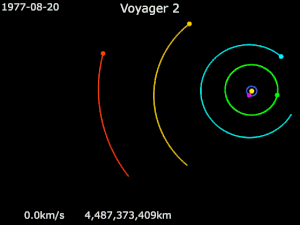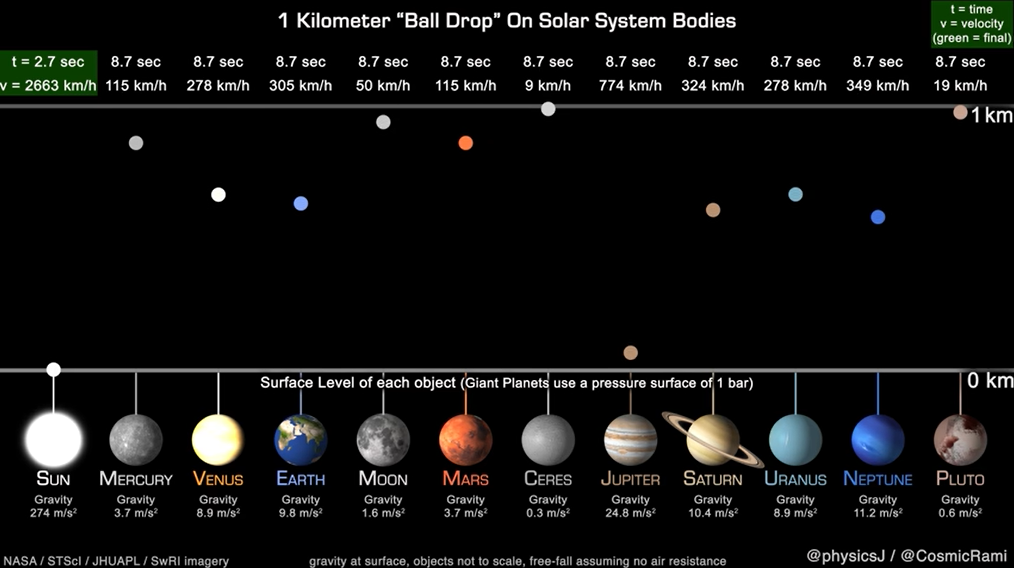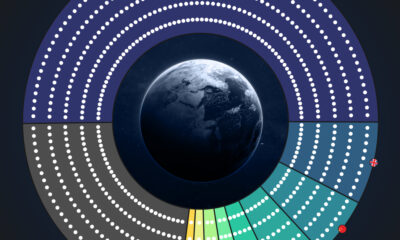Misc
Visualizing the Gravitational Pull of the Planets
Visualizing the Gravitational Pull of the Planets
Gravity is one of the basic forces in the universe. Every object out there exerts a gravitational influence on every other object, but to what degree?
The gravity of the sun keeps all the planets in orbit in our solar system. However, each planet, moon and asteroid have their own gravitational pull defined by their density, size, mass, and proximity to other celestial bodies.
Dr. James O’Donoghue, a Planetary Astronomer at JAXA (Japan Aerospace Exploration Agency) created an animation that simplifies this concept by animating the time it takes a ball to drop from 1,000 meters to the surface of each planet and the Earth’s moon, assuming no air resistance, to better visualize the gravitational pull of the planets.
Sink like a Stone or Float like a Feather
Now, if you were hypothetically landing your spacecraft on a strange planet, you would want to know your rate of descent. Would you float like a feather or sink like a stone?
It is a planet’s size, mass, and density that determines how strong its gravitational pull is, or, how quick or slow you will approach the surface.
| Mass (1024kg) | Diameter (km) | Density (kg/m3) | Gravity (m/s2) | Escape Velocity (km/s) | |
|---|---|---|---|---|---|
| Mercury | 0.33 | 4,879 | 5,427 | 3.7 | 4.3 |
| Venus | 4.87 | 12,104 | 5,243 | 8.9 | 10.4 |
| Earth | 5.97 | 12,756 | 5,514 | 9.8 | 11.2 |
| Moon | 0.073 | 3,475 | 3,340 | 1.6 | 2.4 |
| Mars | 0.642 | 6,792 | 3,933 | 3.7 | 5.0 |
| Jupiter | 1,898 | 142,984 | 1,326 | 23.1 | 59.5 |
| Saturn | 568 | 120,536 | 687 | 9.0 | 35.5 |
| Uranus | 86.8 | 51,118 | 1,271 | 8.7 | 21.3 |
| Neptune | 102 | 49,528 | 1,638 | 11.0 | 23.5 |
| Pluto | 0.0146 | 2,370 | 2,095 | 0.7 | 1.3 |
According to Dr. O’Donoghue, large planets have gravity comparable to smaller ones at the surface—for example, Uranus attracts the ball down slower than on Earth. This is because the relatively low average density of Uranus puts the actual surface of the planet far away from the majority of the planet’s mass in the core.
Similarly, Mars is almost double the mass of Mercury, but you can see the surface gravity is actually the same which demonstrates that Mercury is much denser than Mars.
Exploring the Outer Reaches: Gravity Assistance
Knowing the pull of each of the planets can help propel space flight to the furthest extents of the solar system. The “gravity assist” flyby technique can add or subtract momentum to increase or decrease the energy of a spacecraft’s orbit.
Generally it has been used in solar orbit, to increase a spacecraft’s velocity and propel it outward in the solar system, much farther away from the sun than its launch vehicle would have been capable of doing, as in the journey of NASA’s Voyager 2.

Launched in 1977, Voyager 2 flew by Jupiter for reconnaissance, and for a trajectory boost to Saturn. It then relied on a gravity assist from Saturn and then another from Uranus, propelling it to Neptune and beyond.
Despite the assistance, Voyager 2’s journey still took over 20 years to reach the edge of the solar system. The potential for using the power of gravity is so much more…
Tractor Beams, Shields, and Warp Drives…Oh My!
Imagine disabling an enemy starship with a gravity beam and deflecting an incoming photon torpedo with gravity shields. It would be incredible and a sci-fi dream come true.
However, technology is still 42 years from the fictional date in Star Trek when mankind built the first warp engine, harnessing the power of gravity and unlocking the universe for discovery. There is still time!
Currently, the ALPHA Experiment at CERN is investigating whether it is possible to create some form of anti-gravitational field. This research could create a gravitational conductor shield to counteract the forces of gravity and allow the creation of a warp drive.
By better understanding the forces that keep us grounded on our planets, the sooner we will be able to escape these forces and feel the gravitational pull of the planets for ourselves.
…to boldly go where no one has gone before!
VC+
VC+: Get Our Key Takeaways From the IMF’s World Economic Outlook
A sneak preview of the exclusive VC+ Special Dispatch—your shortcut to understanding IMF’s World Economic Outlook report.

Have you read IMF’s latest World Economic Outlook yet? At a daunting 202 pages, we don’t blame you if it’s still on your to-do list.
But don’t worry, you don’t need to read the whole April release, because we’ve already done the hard work for you.
To save you time and effort, the Visual Capitalist team has compiled a visual analysis of everything you need to know from the report—and our VC+ Special Dispatch is available exclusively to VC+ members. All you need to do is log into the VC+ Archive.
If you’re not already subscribed to VC+, make sure you sign up now to access the full analysis of the IMF report, and more (we release similar deep dives every week).
For now, here’s what VC+ members get to see.
Your Shortcut to Understanding IMF’s World Economic Outlook
With long and short-term growth prospects declining for many countries around the world, this Special Dispatch offers a visual analysis of the key figures and takeaways from the IMF’s report including:
- The global decline in economic growth forecasts
- Real GDP growth and inflation forecasts for major nations in 2024
- When interest rate cuts will happen and interest rate forecasts
- How debt-to-GDP ratios have changed since 2000
- And much more!
Get the Full Breakdown in the Next VC+ Special Dispatch
VC+ members can access the full Special Dispatch by logging into the VC+ Archive, where you can also check out previous releases.
Make sure you join VC+ now to see exclusive charts and the full analysis of key takeaways from IMF’s World Economic Outlook.
Don’t miss out. Become a VC+ member today.
What You Get When You Become a VC+ Member
VC+ is Visual Capitalist’s premium subscription. As a member, you’ll get the following:
- Special Dispatches: Deep dive visual briefings on crucial reports and global trends
- Markets This Month: A snappy summary of the state of the markets and what to look out for
- The Trendline: Weekly curation of the best visualizations from across the globe
- Global Forecast Series: Our flagship annual report that covers everything you need to know related to the economy, markets, geopolitics, and the latest tech trends
- VC+ Archive: Hundreds of previously released VC+ briefings and reports that you’ve been missing out on, all in one dedicated hub
You can get all of the above, and more, by joining VC+ today.
-

 Mining1 week ago
Mining1 week agoGold vs. S&P 500: Which Has Grown More Over Five Years?
-

 Markets2 weeks ago
Markets2 weeks agoRanked: The Most Valuable Housing Markets in America
-

 Money2 weeks ago
Money2 weeks agoWhich States Have the Highest Minimum Wage in America?
-

 AI2 weeks ago
AI2 weeks agoRanked: Semiconductor Companies by Industry Revenue Share
-

 Markets2 weeks ago
Markets2 weeks agoRanked: The World’s Top Flight Routes, by Revenue
-

 Countries2 weeks ago
Countries2 weeks agoPopulation Projections: The World’s 6 Largest Countries in 2075
-

 Markets2 weeks ago
Markets2 weeks agoThe Top 10 States by Real GDP Growth in 2023
-

 Demographics2 weeks ago
Demographics2 weeks agoThe Smallest Gender Wage Gaps in OECD Countries














